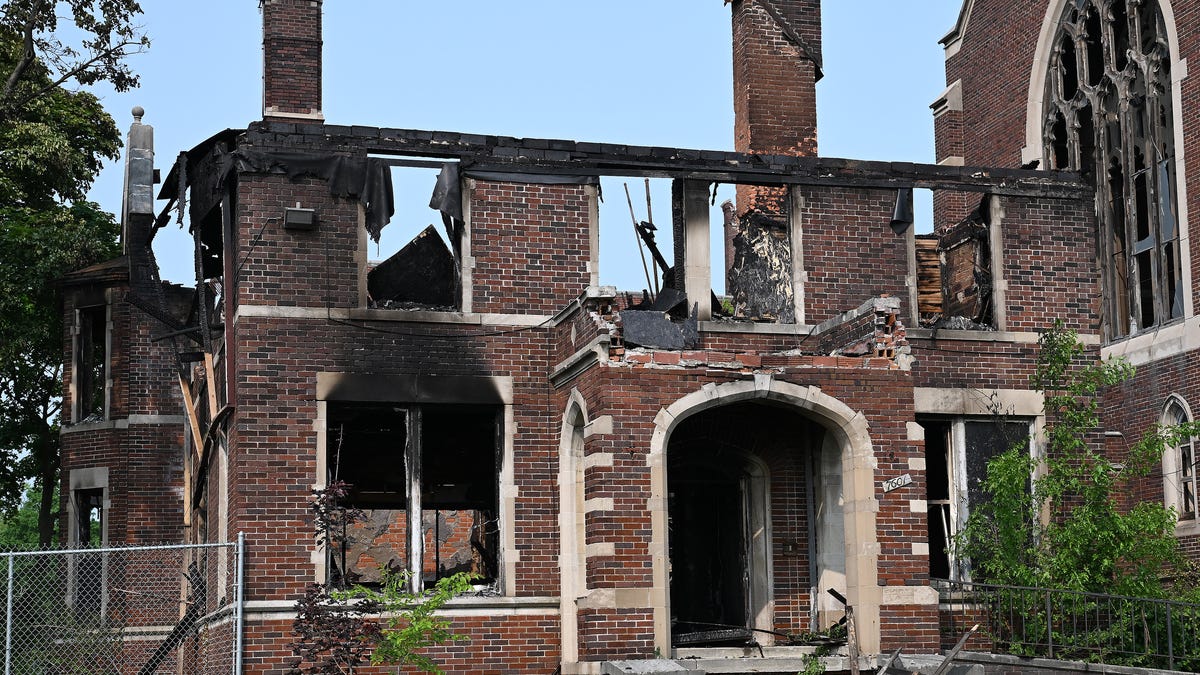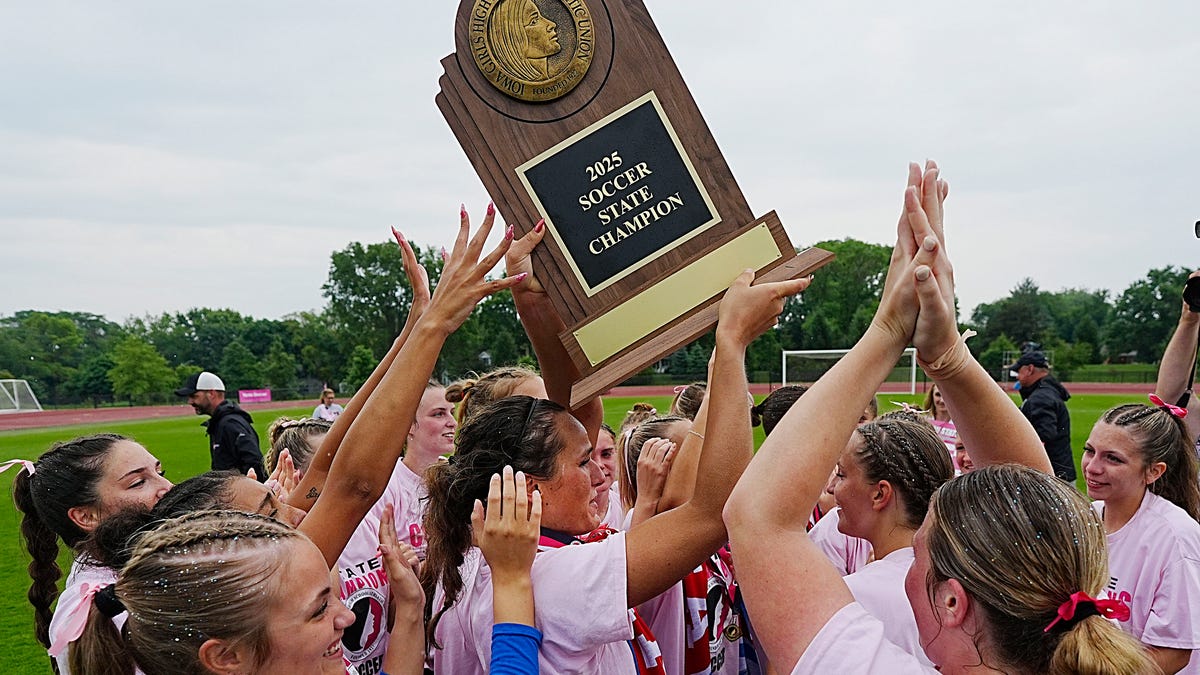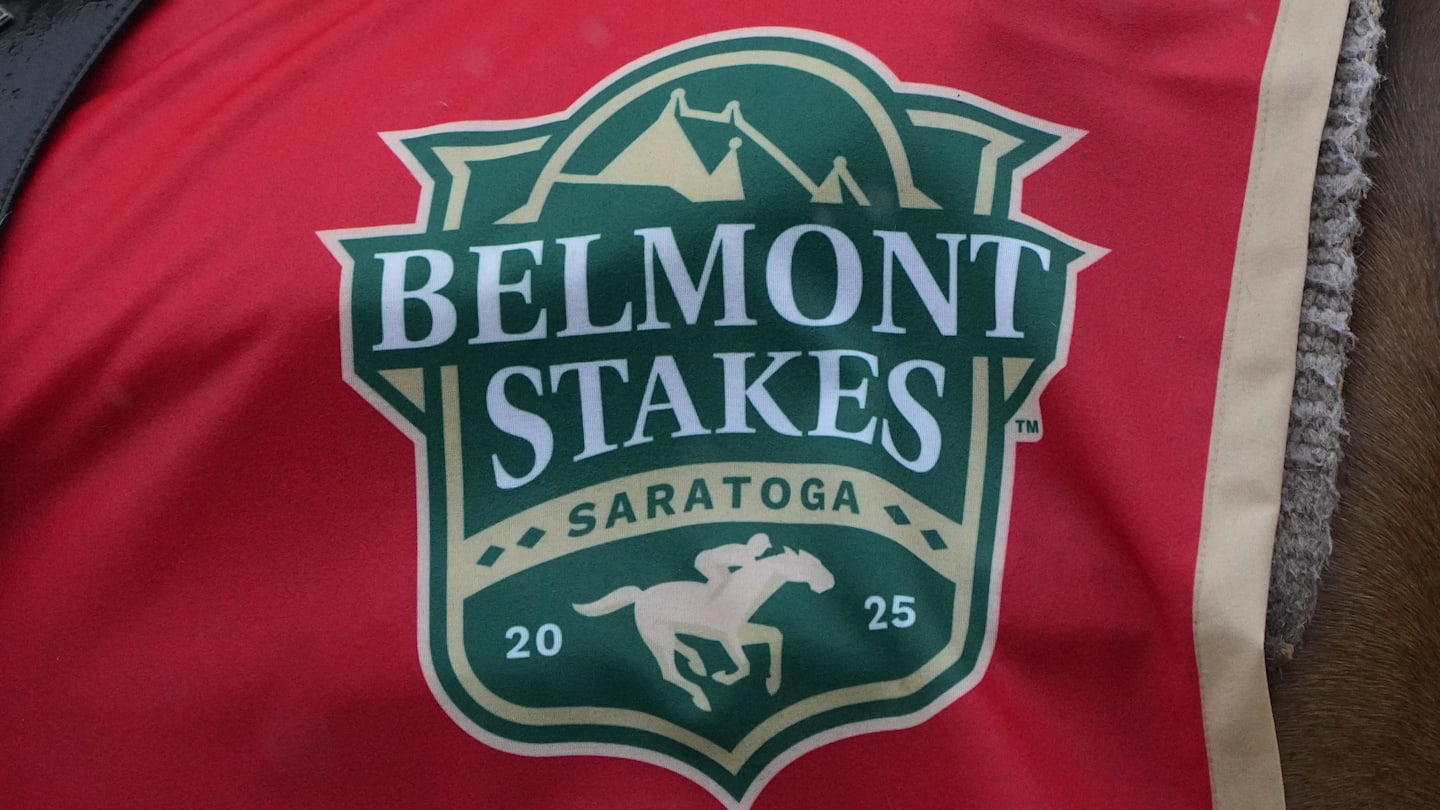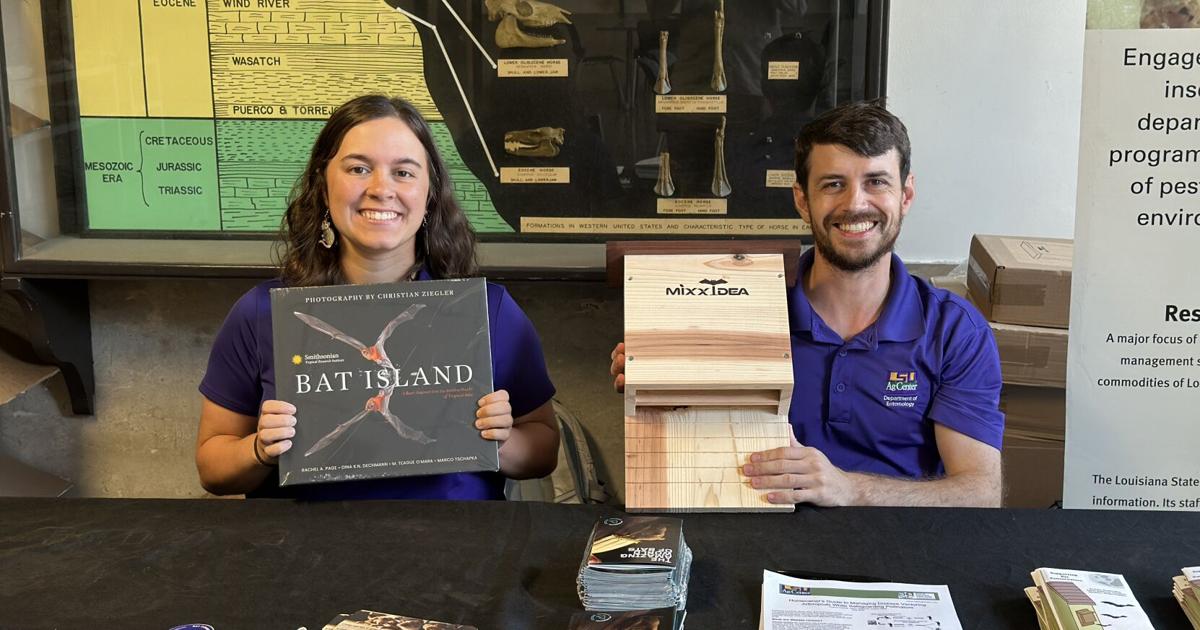Arkansas
Arkansas’ shrinking city: A charter network transforms schools in Pine Bluff • Arkansas Advocate

Davis should know: Relocating here in June 2022, after a nine-year tenure as a professor of special education at Arkansas State University, she recalled, “People were like, ‘Why are you going to Pine Bluff?’ I said, ‘You don’t see what I see. I see potential. And where there is potential, that could be success.’”
‘Every kid here has a voice’
For parent Kazmira Davis (no relation to Kimberly), the moment she knew her kids belonged at the school was in 2018, when her daughter sat for skills tests as one of the school’s first kindergartners. She tested in the second- and third-grade levels in reading and math, respectively. Since then, Davis said, she’s always tested at least a year above grade level. “She hasn’t been stagnant since.”

Nor have her two younger siblings, who are also testing above grade level.
“Our kids have an environment where they feel like they matter,” said Davis, who runs a tutoring and college counseling business. “Every kid here has a voice.”
The approach amounts to what she calls “Go mode,” a constant challenge to both students and teachers to push the limits of what’s possible.
Ten-year-old Kylie, Davis’s oldest at the school, is now a fifth-grader. She pointed out that she has earned straight A’s since kindergarten and has no plans to earn anything less than A’s going forward. “I like the teachers and I have a lot of friends there,” she said.

She wants to go into clothing design and has already created two shirts for her family’s Christian-oriented clothing line. She said teachers focus a lot on helping students figure out what they need to be successful once they graduate.
“Some days in school, they’ll ask you what you want to do when you grow up, and then we’ll have an essay that we have to write,” she said.
Rebecca Newby, one of the school’s academy directors — a job equivalent to an assistant principal — grew up in Pine Bluff and was educated in a district that was long ago swallowed up during one of many rounds of consolidations. In four years, she attended five high schools. She graduated from Pine Bluff High School in 2013, and taught for four years in the nearby Watson Chapel district, remembering that the only times parents were invited on campus were for orientation and parent-teacher conferences, she said. “And those were required days.”
At Friendship Aspire, parent nights are packed, she said. “You can’t even get down the street” because of all the cars parked along the school’s fence-lined street.
Perhaps most importantly, she and others said, students here, about 98% of whom are Black, are immersed — often for the first time — in teaching by well-trained Black instructors, which research shows can have many benefits. In March, researchers at the University of California and the University of North Carolina reported that Black boys, especially from low-income families, are less likely to be referred for special education when they have Black teachers.
Many of Friendship Aspire’s teachers grew up here and were trained at the local branch of the University of Arkansas, an historically Black university. Overall, about 90% of Friendship Aspire staffers are Black.
“I do see it as a long-standing change agent that Pine Bluff has needed for a long time,” said Newby.
‘An exporter of talent’
Many see Friendship Aspire and its sister schools as part of a long-term, perhaps even multi-generational, effort to restore Pine Bluff to its former glory as a haven for well-educated, prosperous families.
But even as the school radiates a contagious, productive energy, it can hardly make up for the loss that so clearly lies at the heart of this community.

Each morning, Mary Ann Lee turns the key to her storefront cafe, Indigo Blue, on a quiet side street off Pine Bluff’s once prosperous Main Street. Originally a dress shop built in 1883, the renovated building now features Instagram-worthy high ceilings and stylish, comfortable seating that wouldn’t be out of place in a college-town cafe. Jazz plays on the stereo and historic civil rights memorabilia, lovingly collected over decades by Lee herself, cover virtually every wall. At the back of the room, an eclectic assortment of books, mostly from Lee’s personal collection, comprise what amounts to an ad-hoc used bookstore.
But as cozy and inviting as Indigo Blue is, the shop looks out onto abandoned storefronts in nearly every direction. A cake shop opened next door a few years ago, and an engraver now operates on the other side of Lee’s cafe, but these few establishments, plus one or two nearby, amount to the largest concentration of functioning businesses for blocks.
It wasn’t always this way.
Just a century ago, the scholar and civil rights pioneer W.E.B. Dubois surveyed the city and found that Pine Bluff had the fourth largest concentration of Black wealth in America. In 1900, a city directory listed 235 Black businesses.

For generations, a passenger railway station greeted visitors in the center of downtown, as did the magnificent six-story neoclassical Pines Hotel and a Black-owned streetcar line.
In the late 1950s, Lee, the cafe owner, recalled, “Pine Bluff used to be ‘the thing,’” a bustling little city with department stores, movie theaters, amusements, a horse racing track and an annual carnival. “You couldn’t even walk on the sidewalks, there’d be so many people,” she recalled.

The city now has exactly zero movie theaters. The streetcar, department stores and amusements are all long gone. Rail service ended in 1968 and the Pines closed in 1970.
After the loss of much of the domestic cotton industry, as well as decades of disinvestment from manufacturers and government, families moved away, abandoning not just businesses but homes. Block after block of crumbling buildings now haunt the quiet streets. The city’s population has never exceeded its 1970s census numbers.
Lee, who attended city schools, remembered that teachers pushed her and other Black students to excel “because integration was coming and we needed to show that we could compete, and that we can learn just like any other kid.”
She left town in the late 1970s, and would go on to a long career promoting human rights and civil rights in Michigan, first with Detroit’s city government and later as a leader of the state NAACP. In that sense, she’s like a lot of Pine Bluff residents who took their good educations and got out.
Over the past century or more, the city has seen a diaspora of smart people leave and, in many cases, never return, said local historian Lori Walker Guelache. They included George Edmund Haynes, co-founder of the National Urban League, and businessman O.W. Gurley, who founded Tulsa’s Greenwood district, otherwise known as “Black Wall Street.”
“We’ve done a great job of cultivating talent historically, but we haven’t done a great job of creating pathways for them to come back,” she said. “And so I guess you can say we’ve been an exporter of talent.”

‘We found it’s a great city’
Those losses have eased somewhat in recent years, she and others said, with small upticks in population for most age brackets — except two: children, as well as adults aged 35 to 44. “So basically young families,” Walker Guelache said.
That reality, among others, drew Friendship to the region. It now runs 11 schools statewide. Already the operator of half a dozen well-respected charter schools in Washington, D.C., it came here in 2018 at the invitation of the Bentonville-based Walton Family Foundation, which admired its work creating a pipeline of Black teachers — especially Black male teachers — in D.C., said Kim Davis, a senior advisor who leads Walton’s work in the Arkansas and Mississippi Delta.

“They’re really good at not only saying, ‘Hey, we think that there is a talented person at the beginning of their career, but we also have a development program for those individuals,’” he said.
Davis also said Friendship’s willingness and ability to partner with the local University of Arkansas campus was critical to attracting more Black teachers to schools here.
But the decision on where to invest was up to Friendship, said Phong Tran, its southern regional superintendent. “Pine Bluff has always been the city that no one wanted to touch,” he said. “But we found that it’s a great city.”
In many educators’ eyes, Friendship Aspire and the six other network schools — they include the new downtown elementary school and a new middle/high school — are leading the push to keep families here. Through its strategic takeovers and new openings, Friendship has quietly built a group of schools that nearly matches the number of remaining district schools, with plans to continue expanding.
A lot of what Friendship has done is to simply offer families a peek into what high-quality schools do, said Friendship Aspire Principal Jherrithan Dukes. Though not a Pine Bluff native, he attended college here at the University of Arkansas and worked at charter and traditional public schools in Little Rock before arriving in the fall of 2020.
Newby, the academic director, said Friendship’s policy to offer free before- and after-care from the beginning showed that it understood the community. “We have working parents that need the support,” she said. “And so we offer that free,” an anomaly in the city.
It doesn’t hurt that the Friendship schools offer nationally recognized curricula that are raising literacy and math skills in ways that other local schools have struggled to do, said Davis, the University of Arkansas dean.
In the most recent state achievement tests, no district-run school earned a grade higher than a D; just 19.4% of third-graders districtwide proved “ready” or exceeding standards in math and 15.4% in reading.
At Friendship Aspire, a different trend is beginning to take shape: 75.9% of students scored “ready” or exceeding standards in math and 33.3% in reading, scores high enough to earn the school a respectable 70.7% rating, a solid C.
When Friendship expanded last year, one show of support was to build the new elementary school in the heart of downtown, partnering with the local public library, which was renovating its downtown building.
“When you want to revitalize a city, what better place to build a school than downtown?” said Tran, the regional superintendent. “There are a lot of parents who come to work downtown. So where are they going to drop their kids?”
For Pine Bluff, that comes with fraught considerations. The city ranks as one of the least safe in the U.S., with more than a dozen teens killed since 2020. So when they designed the new school, architects included a large outdoor space surrounded on all four sides by classrooms to keep students from having to leave the school’s confines to play outside.

Kay’Leah King, 12, a sixth-grader at Friendship STEM Academy, said she thinks a lot about safety, and worries about school shootings, which are often on the news.

She’s glad the school, like Friendship Aspire Academy, which she also attended, keeps its doors locked all day. “On every door that’s on the outside and in the office, you have to have a key code to get in,” she said. “And you can’t get in without it. You can’t get in through those doors without being let in.”
Best in the state
Dukes said many of his students’ parents vividly remember the substandard education they got in Pine Bluff just a few years ago — and don’t want a repeat experience with their kids.
As a result, they fiercely support the school, organizing events such as the annual “Trunk or Treat,” a Halloween tradition in which they park cars outside the school and essentially recreate house-to-house trick-or-treating for students who may not be able to do it otherwise. Several parents said the city’s violent crime rate makes them think twice about letting their kids go house-to-house each October.

The school is tidy and orderly. On a recent morning, Dukes patrolled the halls, reminding students to cross their arms in front of them as they pass between classrooms to keep their hands to themselves.
Davis, the Arkansas dean, said her students, teachers in training, push to work at Friendship Aspire and the other network schools, lured by their energy. In a sense, she said, salaries have become less important due to a 2023 state law that raised public school teachers’ minimum salaries from $36,000 to at least $50,000. That puts the burden on schools to support teachers in other ways.
People were like, ‘Why are you going to Pine Bluff?’ I said, ‘You don’t see what I see. I see potential.
– Kimberly Davis, dean, School of Education, University of Arkansas at Pine Bluff
Last fall, Friendship brought in the D.C. coaching firm SchoolKit, which provides literacy coaches to work with small groups of students. The Arkansas Public Schools Resource Center also provides tutors and helps teachers pace lessons. And the school partnered with the Detroit-based Center for Strategic Leadership, which helps teachers improve math instruction and provides retention bonuses for those who stick around.
More importantly, Friendship is offering what many here never got during their K-12 schooling: a plethora of well-trained Black educators.
Countless adults here can recount the experience of attending school with mostly Black classmates but mostly white teachers. “Growing up, the majority of my teachers did not look like me,” said Friendship Aspire Academy Director Brianna Reynolds, who began here as a kindergarten teacher in 2018.

In many years, she said, her only Black teacher was her home economics teacher.
From kindergarten on up, Dukes and others said, Friendship principals prioritize hiring Black teachers. At the new Friendship high school, they comprise half of Principal Anitra Rogers’ staff. She recounted literally praying to God to provide the campus with the teachers it needed, “preferably with Black men.”
The result is a small but growing set of schools that are quietly changing people’s minds about the city, said Reynolds one recent morning. “It changes the narrative.”
As if to underscore the change, that morning as he chatted with Reynolds and other staffers in his office, Dukes received a flat cardboard parcel in the day’s mail. He sliced it open to reveal a gleaming glass plaque: Friendship Aspire had been named a U.S. News & World Report “Best Elementary School.” The magazine, which ranks schools and colleges nationwide, named Friendship Aspire the 28th-best elementary school in Arkansas and its No. 1 charter elementary school.
As he scanned the plaque, colleagues cheered. Dukes beamed, saying repeatedly, “There it is. There it is.” He held it up to pose for photos. “There it is.”

‘We’re raising a great generation of students’
Meanwhile, in downtown Pine Bluff, small signs of life are beginning to peek through. A new aquatic center, proposed in 2011, finally opened in 2019. The historic hotel’s owner sold it for $1 to a nonprofit named Pine Bluff Rising, which plans to revitalize it.
And Lee, the cafe owner, is now thinking about renovating the second story of her building to create a loft apartment for her retirement. Forever busy scheduling speakers at the cafe and working with other building owners on downtown preservation projects, she’s excited about the new possibilities.
Each morning, she looks out her renovated storefront windows and across West Barraque Street onto a block of three abandoned, brick-wrapped buildings. Their owner says he’s finally ready to renovate them, with plans for an ice cream shop, loft apartments and a martini bar.
But all of these efforts, locals said, need families to stick around.
Friendship continues to explore new schools and new takeovers, even as the State Board of Education last fall voted unanimously to return full local control of Pine Bluff schools to the district. State officials will continue monitoring the district’s academic and fiscal performance for another year.
For his part, Dukes, the elementary school principal, is cautiously optimistic — and patient. He believes real change in the city may take years.
“I feel like once these kids get older and get grown and come back to this community, we’re going to see a real take-off in the city,” he said. He’s not actually sure he’ll be around to see it, but he’s convinced a rebirth is at hand. “I feel like we’re raising a great generation of students.”
Disclosure: Walton Family Foundation provides financial support to The 74. The foundation also provided early financial support to the Friendship Education Foundation to set up a charter network in Pine Bluff.
This story first appeared at The 74, a nonprofit news site covering education. Sign up for free newsletters from The 74 to get more like this in your inbox.

Arkansas
‘Devil in the Ozarks’ fugitive captured after 12-day Arkansas manhunt

Ex-Arkansas police chief imprisoned for murder escapes prison
Grant Hardin, a former Gateway, Arkansas, police chief serving time for murder and rape, escaped from the North Central Unit in Calico Rock on May 25.
unbranded – Newsworthy
A former Arkansas police chief who escaped from a prison where he was serving decades-long sentences for murder and rape was captured June 6 after a 12-day manhunt involving federal, state and local law enforcement.
Grant Hardin, known as the “Devil in the Ozarks,” was caught around 3 p.m. local time just a mile and a half from the prison he escaped nearly two weeks earlier, according to Arkansas Department of Corrections spokesperson Rand Champion. Hardin, 56, was thought to have fled the state.
Tracking dogs picked up Hardin’s scent west of the prison near Moccasin Creek in Izard County, according to Champion. Photos of Hardin’s arrest show him wearing a sullied shirt. His face appears thinner than in earlier mugshots.
“Thanks to the great work of local, state and federal law enforcement Arkansans can breathe a sigh of relief and I can confirm that violent criminal Grant Hardin is back in custody,” said Arkansas Governor Sarah Huckabee Sanders. “I am grateful for all law enforcement who contributed to his capture and give special thanks to the Trump administration and Secretary Kristi Noem, who sent a team from Border Patrol that was instrumental in tracking and apprehending Hardin.”
Arkansas law enforcement authorities and U.S. Border Patrol agents participated in the arrest, according to Champion.
“This was a great joint operation by a number of agencies, and I’m so thankful for their tireless efforts,” said Dexter Payne, director of the Arkansas Division of Correction. “The Arkansas State Police, U.S. Marshals, FBI, Border Patrol, Game and Fish, all the state and local agencies, along with the dedication of our Department employees, all played an indispensable role and I express my extreme gratitude.”
Hardin had gained notoriety as the subject of the 2023 documentary “Devil in the Ozarks’’ about his 1997 rape of a school teacher and 2017 murder of a water department worker.
Hardin fled the North Central Unit prison in Calico Rock, Arkansas, through a secure entryway on May 25 wearing a fake law enforcement uniform. His disguise caused a corrections officer to open a gate and let him walk out of the medium-security facility.
Discover WITNESS: Access our exclusive collection of true crime stories, podcasts, videos and more
The escape followed the May 16 jailbreak of 10 inmates in New Orleans – several of them charged with murder – which drew national attention and caused consternation in area communities.
Hardin was regarded as no less dangerous a fugitive. In 2017 he was convicted of killing James Appleton, an employee of the northwest Arkansas town of Gateway whose brother-in-law, Andrew Tillman, was the mayor. Tillman told investigators they were talking on the phone when Appleton was shot to death in his pickup truck.
A DNA test conducted following the murder connected Hardin to an unresolved 1997 rape in Rogers, Arkansas, according to a probable cause affidavit filed in the case. The teacher was attacked at gunpoint after leaving her classroom to go to a restroom near the teacher’s lounge, according to the affidavit.
Like true crime? Check out Witness: A library of true crime stories
Where did Hardin work in law enforcement?
Hardin’s combined convictions, including two counts of rape, added up to 80 years in prison sentences.
“He’s a sociopath,’’ former Benton County prosecutor Nathan Smith told Arkansas ABC affiliate KHBS/KHOG. “Prison’s not full of people who are all bad. It’s full of a lot of people who just do bad things. Grant’s different.’’
Hardin had an erratic career in Arkansas law enforcement starting in 1990, working for police departments in Fayetteville, Huntsville and Eureka Springs before briefly serving as Gateway’s police chief in 2016.
He was fired from the Fayetteville job after less than a year because of subpar performance and failure to accept constructive criticism, according to KHBS/KHOG. In Huntsville, where he worked from April 1993 to October 1996, the former police chief told the TV station Hardin used excessive force and made poor decisions.
Escaping from prison, for which he now faces charges, may be just the latest one.
Contributing: N’dea Yancey-Bragg, Michael Loria and James Powel, USA TODAY
Arkansas
Arkansas football to host out-of-state recruits | Whole Hog Sports

Arkansas
Arkansas medical marijuana sales up more than 6% through May – Talk Business & Politics

Arkansas medical marijuana sales in the first five months of 2025 totaled $121.024 million, up 6.3% compared with the same period in 2024. Overall pounds sold in the first five months was 32,474, above the 30,000 in the same period of 2024.
Medical marijuana sales totaled $275.9 million in 2024, just below the record of $283 million in 2023.
“Tax revenue from medical marijuana is averaging $2.68 million a month in 2025, also an increase over last year,” Scott Hardin, spokesperson for the Arkansas Department of Finance and Administration (DFA), said in a statement. “With daily medical marijuana sales averaging $806,000, we are on track to surpass the 2023 sales record of $283 million.”
Following are the top five dispensaries, among the state’s 37 licensed dispensaries, for pounds sold in May.
Suite 443 (Hot Springs): 692.98 pounds
Natural Relief (Sherwood): 626.54
Harvest (Conway): 422.78
CROP (Jonesboro): 401.24
Custom Cannabis (Alexander): 363.13
The Arkansas Department of Health reported 109,854 active patient cards, up 12.8% compared with the 97,374 to begin 2024.
Following are the annual sales since 2019 when medical marijuana sales began in Arkansas.
2024: $275.9 million
2023: $283 million
2022: $276.3 million
2021: $264.9 million
2020: $181.8 million
2019: $31.32 million
The constitutional amendment legalizing medical marijuana for 17 qualifying conditions and creating a state medical marijuana commission was approved by Arkansas voters 53% to 47% in November 2016.
Taxes collected are 6.5% of regular state sales tax with each purchase by a patient and a 4% privilege tax on sales from cultivators to dispensaries. Most of the tax revenue is placed in the University of Arkansas for Medical Sciences National Cancer Designation Trust Fund. The state also collects a cultivator privilege tax, which means tax revenue is not always tied to how much product is bought by consumers at dispensaries and the price for the product sold to dispensary customers.
Related
-

 News1 week ago
News1 week agoVideo: Faizan Zaki Wins Spelling Bee
-

 News1 week ago
News1 week agoVideo: Harvard Commencement Speaker Congratulates and Thanks Graduates
-

 Politics7 days ago
Politics7 days agoMichelle Obama facing backlash over claim about women's reproductive health
-

 Politics1 week ago
Politics1 week agoMusk officially steps down from DOGE after wrapping work streamlining government
-

 Technology1 week ago
Technology1 week agoAI could consume more power than Bitcoin by the end of 2025
-

 News1 week ago
News1 week agoPresident Trump pardons rapper NBA YoungBoy in flurry of clemency actions
-

 Technology1 week ago
Technology1 week agoSEC drops Binance lawsuit in yet another gift to crypto
-

 Technology1 week ago
Technology1 week agoOpenAI wants ChatGPT to be a ‘super assistant’ for every part of your life

















